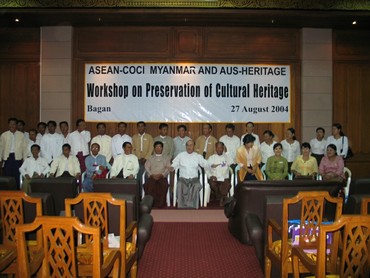The three day symposium at Yangon was the culmination of negotiation and planning by AusHeritage Board members in association with Myanmar representatives of ASEAN COCI. The program consisted of two days of papers – which all produced lively discussion and debate – covering aspects of museum management, museum climate control, conservation of objects, impacts of tourism, interpretation and town planning for heritage areas followed by a day of dual workshop discussions. The interchange of ideas, comparison of cross cultural and inter-country issues and problems, and realisation of opportunities for future action was stimulating. There were eighteen delegates mainly from Australia but including one from New Zealand, India, and Japan. In addition there were over fifty observers from Myanmar including academics, practitioners, students, and managers.

The opening ceremony set a positive agenda for the three days with HE Major General Kyi Aung, Myanmar Minister for Culture, welcoming delegates and outlining Myanmar’s interest in its culture and heritage; Daw Nanda Hmun, Director of the Department of Cultural Institute, set out the range of professional work in Myanmar; Vinod Daniel, Chair of AusHeritage, explained Ausheritage’s keenness to co-operate in all aspects of heritage conservation through the ASEAN family in the Asia-Pacific region.
Over the first two days twenty-two papers were presented, of which nine were by Myanmar speakers. Each speaker was allocated 20 minutes with ten minutes for discussion with participants. It is to the credit of the combined chairs of each session and the discipline of the speakers that the timetable ran smoothly.
Myanmar topics covered preservation of monuments in Myanmar, architectural conservation, conservation of mural paintings, tourism management, urban renewal of colonial buildings in Yangon, preservation of ancient manuscripts, museum management and protection of moveable properties. A consistent theme running through the Myanmar papers was the connection between places and objects and everyday life and the importance of intangible values alongside physical fabric.

Papers from AusHeritage participants included preserving intangible values and the World Heritage convention, conservation area planning, conservation and interpretation dilemmas at Borobudur, conserving the material heritage of the Chinese diaspora, applying Burra Charter to intangible values, costs and benefits of cultural tourism, holistic approaches to sustainable collections, museum environments for sustainable collections, preventative conservation in small museums, maritime cultural heritage, mitigating risks to cultural heritage in an area of ethno-religious and political conflict, and heritage as a community asset and policy related issues in Japan.
On the third day two workshops ran concurrently. One focussed on town planning and building conservation which started with a site visit to the handsome nineteenth century colonial area of Yangon by the river abutting Strand Road. A quick windscreen assessment was undertaken and analysis of patterns and components of the historic townscape-streetscape area. Afterwards approaches to urban conservation were discussed with Myanmar representatives. It was agreed that further contact and discussion could take place via email as the town planning department in Yangon progressed with the study.

The other workshop focussed on collections and conservation and highlighted risk based approach, disaster planning, exhibitions and collection management approaches. The workshop was attended by staff from the National Museum, Library and Archives as well as many regional museums.
The conference was followed by a joint 3 day meeting between AusHeritage and the Myanmar Department of Archaeology on the historical site of Bagan. The meeting included visits to significant sites as well as joint workshops and discussion groups. The recommendations included:
* Options to categorise the site as a Continuing Cultural Landscape.
* Development of a plan for pedestrian and vehicle movement in Bagan.
* Identification of sites that can sustainably support visitation
* Prohibit access to monuments and use of monuments as viewing platforms (unless by special permission)
* Development of a transport management plan
* Increase visitor amenities in the site
* Additional documentation of site features using GIS mapping and remote sensing
* Expansion of the current interpretation to include a broader historic presentation of the site
* Establishment of a priority list and a strategy for ongoing protection of mural paintings
* Periodic review of the zoning boundary.
* Establishment of a conservation laboratory for testing and analysis of materials to be used for conservation work throughout Myanmar.
* Development of a coordinated collection management and preservation plan
* Establishment of an objects’ conservation facility at the Bagan Museum.
* Expansion of the current Bagan museum objects’ register to include objects stored both onsite and offsite.
* The role of the Bagan museum be enhanced as a focus of cultural tourism on the site.
AusHeritage will be working closely with the Myanmar Ministry for Culture to collaborate on specific recommendations. Please let any of the AusHeritage board members know if you need any additional information or you are keen to be involved as we continue building on this initiative.
Vinod Daniel
Chairman, AusHeritage
